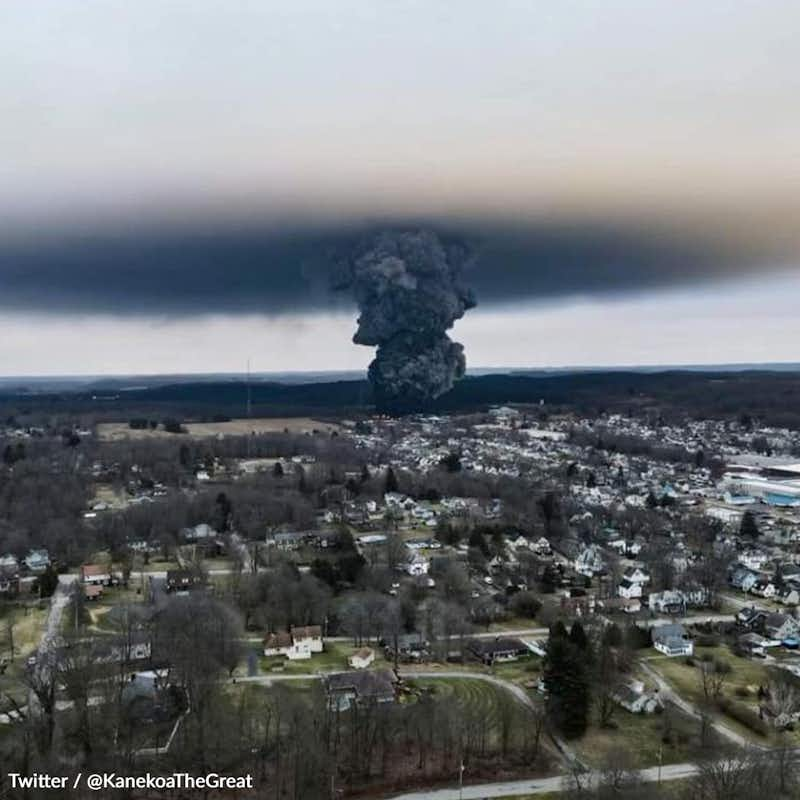Stop Toxic Train Derailments from Putting Americans at Risk
6,247 signatures toward our 30,000 Goal
Sponsor: The Rainforest Site
Preventing these disasters is a matter of transportation and industrial safety, as well as national security. Take action for the safety of all Americans!

The people of East Palestine, Ohio, experienced growing health and environmental concerns following the release of toxic fumes from a train derailment1. The derailment caused a fire in the area that lasted for days, and ten of the 50 derailed cars contained hazardous chemicals such as butyl acrylate and vinyl chloride. Authorities were concerned that these combustible liquids could set off a major explosion, which led to residents being asked to evacuate as a precaution2.
The situation in East Palestine serves as a stark reminder of the potential dangers of transporting hazardous materials and the importance of ensuring that these materials are handled with the utmost care.
With the surge in rail transport of hazardous materials in the US, the risk of accidents like the one in East Palestine has increased significantly3. In 2022, hazardous chemicals were released during 11 train accidents nationwide, according to Federal Railroad Administration data, out of roughly 535 million miles (861 million kilometers), with only two injuries reported. Releases of hazardous materials peaked at 20 in 2018 and 20204.
To address this issue, it's time for the Environmental Protection Agency (EPA) to use the authority it was given in the 1990 Clean Air Act to prevent chemical disasters at their source and to require all chemical producers and users to adopt safer processes and chemicals5. The EPA's Risk Management Program (RMP) is designed to prevent accidents like the one in East Palestine by requiring companies that use or store hazardous materials to develop risk management plans, conduct audits and inspections, and report accidents and incidents to the public. However, the RMP has not been updated since 1996, and it is outdated and ineffective at preventing chemical accidents6.
We're urging the EPA to issue new RMP safety standards that prioritize hazard reduction at the plant level. This would require companies to use safer chemicals and processes, invest in better infrastructure and emergency response plans, and provide more public information and transparency about their operations.
Preventing railway disasters is not just a transportation and industrial safety concern, it's a national security issue, and we need to act now before it's too late.
If you care about the safety of your community, the health of your loved ones, and the future of our country, join the movement to protect Americans from this type of disaster. Sign our petition urging the EPA to issue new RMP safety standards today!
- Juliana Kim, NPR (14 February 2023), "Health concerns grow in East Palestine, Ohio, after train derailment."
- Li Cohen, CBS News (14 February 2023), "One of the materials on the derailed Ohio train is linked to a rare and "exceptionally deadly" cancer. Here's what to know about the other substances on board.."
- Industrial Safety & Hygiene News, Tony Scarrow, "3 potential risks when transporting hazardous materials by rail."
- Transportation.gov (15 February 2023), "Rail Equipment Accident/Incident Data."
- United States Environmental Protection Agency (28 November 2022), "1990 Clean Air Act Amendment Summary."
- United States Environmental Protection Agency (1 November 2022), "Risk Management Program (RMP) Rule."
The Petition:
To the Administrator of the Environmental Protection Agency (EPA),
I am deeply concerned about the disaster that occurred in East Palestine, Ohio, where derailed train cars released toxic fumes, forcing Americans to evacuate their homes and saddling them with debilitating health issues.
The EPA has the power to prevent such disasters from happening in the future by issuing new risk management plan (RMP) safety standards that prioritize hazard reduction at the plant level.
I urge the EPA to take a common sense approach and require all chemical producers and users to adopt safer processes and chemicals. By doing so, the amount of hazardous cargo shipped daily through our communities can be significantly reduced. Most chemical facilities have readily-available options ranging from safer chemical substitutes to “just-in-time” production processes that use the same chemicals but eliminate the need for storage and transport of bulk quantities of deadly chemicals.
I believe that the urgent need for taking these steps is not solely a question of transportation and industrial safety. It’s also a national security concern as well. There are about 100,000 miles of largely unguarded railroad tracks in the U.S. Trains carrying hazardous bulk cargo are like rolling chemical plants without fencing or security.
I call on the EPA to issue new RMP safety standards that prioritize hazard reduction at the plant level, which would reduce the amount of hazardous rail cargo that travels through populated areas, and prevent disasters like that which recently occurred in East Palestine, Ohio.
Thank you for your attention to this urgent matter.
Sincerely,